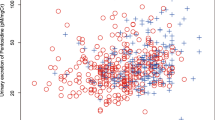Abstract
The urinary excretion of pyridinolines either in the free form or linked to different peptide fragments of type I collagen are intensively studied as new biochemical markers of bone resorption. In the present study we compared the urinary excretion of free pyridinoline (F-Pyr) determined by enzyme-linked immunosorbent assay (ELISA) (Collagen CrosslinksTM Kit, Metra Biosystems) to pyridinoline (Pyr), and deoxypyridinoline (D-Pyr) determined by high performance liquid chromatography (HPLC) in early postmenopausal women treated with either hormone replacement therapy or placebo and in healthy age-matched premenopausal women. Other markers of bone metabolism were included for comparison. Compared with the premenopausal women, the postmenopausal women had significantly increased values of the biochemical parameters. F-Pyr, Pyr, D-Pyr, and T-Pyr (=Pyr+D-Pyr) decreased during hormone therapy. D-Pyr correlated with the rate of bone loss, whereas this was not the case for F-Pyr. The correlations between the markers yielded r values of 0.71 (F-Pyr vs Pyr), 0.67 (F-Pyr vs D-Pyr), and 0.71 (F-Pyr vs T-Pyr). In conclusion, the present study shows that the newly introduced ELISA for determination of the free pyridinolines is less sensitive than pyridinium crosslinks measured by high performance liquid chromatography (HPLC) in hydrolyzed urine for the changes in calcium metabolism that occur at menopause and during hormone replacement therapy. Whether this limitation will be balanced out by avoiding the inconvenience of the complicated, expensive, and timeconsuming HPLC procedure is still being debated.
Similar content being viewed by others
References
Delmas PD (1991) Biochemical markers of bone turnover: methodology and clinical use in osteoporosis. Am J Med (suppl 5B): 59s–63s
Gundberg CM, Lian JB, Gallop PM, Steinberg JJ (1983) Urinary gamma-carboxy-glutamic acid and serum osteocalcin as bone markers: studies in osteoporesis and Paget's disease. J Clin Endocrinol Metab 57:1221–1225
Uebelhart D, Gineyts E, Chapuy M-C, Delmas PD (1990) Urinary excretion of pyridinium crosslinks: a new marker for bone resorption in metabolic bone disease. Bone Miner 8:87–96
Riis BJ, Thomsen K, Strøm V, Christiansen C (1987) The effect of percutaneous estradiol and natural progesterone on postmenopausal bone loss. Am J Med 1:61–65
Christiansen C, Riis BJ, Rødbro P (1987) Prediction of rapid bone loss in postmenopausal women. Lancet i:1105–110
Christiansen C, Riis BJ, Rødbro P (1990) Screening procedure for women at risk of developing postmenopausal osteoporosis. Osteoporosis Int 1:35–40
Hansen MA, Overgaard K, Riis BJ, Christiansen C (1991) Role of peak bone mass and bone loss in postmenopausal osteoporosis: 12-year study. BMJ 303:961–964
Eyre DR, Koop TJ, Van Ness KP (1984) Quantitation of hydroxypyridinium crosslinks in collagen by high performance liquid chromatography. Analyt Biochem 137:380–388
Eyre DR, Dickson IR, Van Ness K (1988) Collagen crosslinking in human bone and articular cartilage. J Biochem 252:495–500
Uebelhart D, Schlemmer A, Johansen JS, Gineyts E, Christiansen C, Delmas PD (1991) Effect of menopause and hormone replacement therapy on the urinary excretion of pyridinium crosslinks. J Clin Endocrinol Metab 72:367–373
Seyedin SM, Kung VT, Daniloff YN, Hesley RP, Gomez B, Nielsen LA, Rosen HN, Zuk RF (1993) Immunoassay for urinary pyridinoline: the new marker of bone resorption. J Bone Miner Res 8:635–641
Delmas PD, Gineyts E, Bertholin A, Garnero P, Marchand F (1993) Immunoassay of pyridinoline crosslink excretion in normal adults and in Paget's disease. J Bone Miner Res 8:643–648
Riis BJ, Jensen J, Christiansen C (1987) Cyproterone acetate, an alternative gestagen in postmenopausal estrogen/gestagen therapy? Clin Endocrinol 26:327–334
Pødenphant J, Larsen N-E, Christiansen C (1984) An easy and reliable method for determination of urinary hydroxyproline. Clin Chim Acta 142:145–148
Johansen JS, Mølholm Hansen JE, Christiansen C (1987) A radioimmunoassay for bone Gla protein (BGP) in human plasma. Acta Endocrinol 114:410–416
Nilas L, Borg J, Gotfredsen A (1985) Comparison of single and dual photon absorptiometry in postmenopausal bone loss. J Nucl Med 26:1257–1262
Author information
Authors and Affiliations
Rights and permissions
About this article
Cite this article
Fledelius, C., Riis, B.J., Overgaard, K. et al. The diagnostic validity of urinary free pyridinolines to identify women at risk of osteoporosis. Calcif Tissue Int 54, 381–384 (1994). https://doi.org/10.1007/BF00305523
Received:
Accepted:
Issue Date:
DOI: https://doi.org/10.1007/BF00305523




